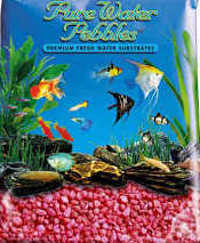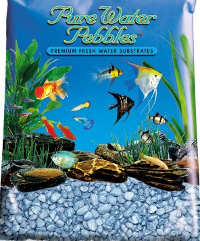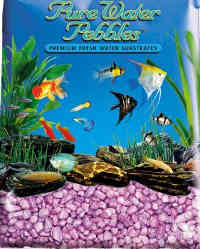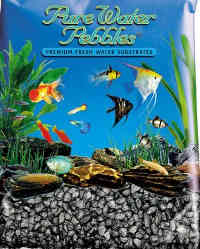For brand new aquarists to those with 10 years under their belt, getting the best aquarium gravel is key for starting your new tanks off right. This means knowing your fish and plants substrate requirements, what effects adding specific gravel will have on your PH and even how the gravel will look in a finished tank.
Learn about other types of substrate here.
Importance of Finding the Best Aquarium Gravel
While tanks are perfectly capable from going bare bottom, no substrate, it is far from recommended. Gravel has a huge number of benefits, far more than people realize as it simply rests on the ground.
Gravel:
-
- Creates more surface area for beneficial bacteria and fights water toxicity
Without gravel owners will find themselves in need of multiple water changes a week, often even daily, just to keep their fish alive. The missing element of the substrate allows ammonia and nitrites to run rampant, and the beneficial bacteria that grows on all of your aquariums surface is the answer. By laying gravel across the bottom of your aquarium you aid the bacteria, allowing it to fight off these toxins and make aquarium maintenance much easier.
-
- Allows plants a substrate to take root
Bare bottom tanks and sand tanks will find housing plants to be more difficult than gravel users. Bare bottoms will need something to hold them in place, where as sand is easily blown away when it is not compacted. Digging up the sand un-compacts it, meaning your plant will need to be held in place until it roots itself naturally.
Rather than go through all that trouble, gravel easily rests atop the roots, allowing even single stem plants to stay put as they grow roots.
When plants get too numerous or are no longer desired, the easy to manage gravel will let go of the roots. This makes dealing with rapid growing plants and hair algae a breeze.
-
- Provides ground walking inhabitants a more comfortable floor
Many tanks will find themselves housing creatures who love to walk about the surface. Crabs, shrimp and cory cat fish all like to have some form of substrate to travel across. Those who are scavengers will have an easy time removing the unwanted debris from the gravel, giving them food without it blowing around the tank.
-
- Prevents reflective light from agitating fish
While this last point may seem silly, many fish are already on edge when placed into our aquariums. With stress being the number one fish killer, every little thing we can do helps. Most substrate will absorb light better than the glass bottom. Be wary of glass/white substrates, which will often spook fish when paired with powerful lights.
With substrate being so important and gravel being one of the cheapest elements of a home aquarium, picking up a bag will easily help your tank. There are some differences in gravel you must take into account.
Warning: Because of the increasing popularity in the fish keeping hobby, many low quality gravel have come into play. Be on the look out for vase rocks or gem like gravel. These are often painted glass and can be very harmful to fish, even those that are sold as aquarium substrate.
Gravel Properties
Size
When selecting your gravel you need to take into consideration everything that is going into your tank. High water flow angled downwards can cause a problem with tiny gravel. For ground walkers and snails small gravel may be the better choice. Plecostomus will love to munch on large pieces of gravel as they suck off the algae and many shrimp enjoy holding the large pieces in their many hands as they eat. Plants can easily spread their roots in both sizes, and algae can sink further into large gravel. Some fish even like to burrow into small gravel!
Ultimately smaller gravel need less, but more difficult, maintenance and are favored by most creatures. If however you own only free swimming fish and cleaner shrimp large gravel may be more your style. If you have tank mates who require different gravel you can even get two smaller bags of each, getting the benefits of both.
Color
While this is a choice of preference we still want to make sure new owners don’t buy without thinking ahead. Sure green gravel can look beautiful and provide a rich background. Add in a couple plants and there’s suddenly too much green. Likewise with black gravel it may be too dim if you have dark fish with few decorations. Remember the aquariums are supposed to be unique and vibrant. Try a color you don’t see every day or even mix two colors together. Solid black combined with grey stones can give you a rich charcoal effect while green and pink produce an uplifting spring time vibe.
Savvy owners can even match and contrast their gravel with their fish. Everyone knows the combo of glow fish and black gravel. Dazzle your visitors by contrasting black and red fish with a lighter color. Conversely white/silver fish with dark colors can make a beautiful pairing.
Depth
If you do not want any live plants and have few scavengers, just an inch will serve your tank well. This will save you both space and money. For those tanks full of plants and various burrowing fish a 3 inch deep bed creates a more suitable environment
Common Misbeliefes
Due to owners adding rocks, wood and plants to their gravel, people have created false truths about aquarium gravel.
PH and Hardness
Aquarium gravel, unless otherwise stated, is inert and will not change the PH level or increase water hardness. The reason this idea has been seen as fact is the addition of rocks atop the gravel, which are often highly calcareous will both harden water and increase PH. If you are adding these rocks and do not want higher PH add non petrified wood to counteract the rocks.
Gravel Clogs Siphons
While this is possible, it should not happen unless you are absolutely burying your siphon into the gravel or have such a powerful suction it is not fish safe. When held against even small gravel, siphons will only lift the substrate a small amount. moving the siphon back an inch will immediately see all gravel dropped.
Gravel is childish
Wrong, fish are childish
The Rainbow Selection
After a great deal of searching, quality checks and web design our color rainbow is here to help you find the best aquarium gravel. All gravel comes from amazon, most having free shipping!
Preparing Gravel
Once you have your gravel in hand take a day to soak it in water. No matter how high quality the product is or where they are purchased, all items are subject to shipping and handling.
Fill a bucket or pitcher with water and swirl the gravel around a few times throughout the day. Each time more and more organic material will be cleaned from the rocks. Upon your final swirl, spin the water even faster than usual and slowly drain out the water. All the debris will float out on the water and you will be left with deep cleaned gravel that’s ready for your fish tank. Even the best aquarium gravel needs to be cleaned to avoid cloudy water.

















